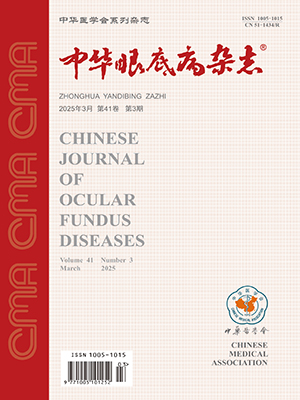Objective To observe the efficacy of different administration of conbercept on choroidal neovasculature (CNV) in patients with pathological myopia (PM).Methods A retrospective case-control study. From June 2012 to June 2017, 57 patients (61 eyes) with PM-CNV diagnosed in the Ophthalmology Department of General Hospital of Central Theater Command were included in this study. All patients underwent BCVA, intraocular pressure, refractive index, slit lamp microscope, FFA, OCT examination and axial length (AL) measurement. An international standard vision chart was used in the BCVA test, which was converted to logMAR vision. According to the initial treatment plan, the patients were divided into 1+PRN treatment group (group A) and 3+PRN treatment group (group B), with 27 patients (31 eyes) and 30 patients (30 eyes), respectively. There was no significantly statistical difference in baseline data between the two groups (P>0.05). The eyes was injected with 10 mg/ml of conbercept 0.05 ml (including conbercept 0.5 mg). After completion of initial treatment, on-demand treatment was performed according to repeated treatment standards. The average follow-up time was 30.8 months. The time point for curative effect determination was 24 months after treatment. The frequency and recurrence rate of vitreous cavity injections in the two groups of patients and the changes of BCVA, central macular thickness (CMT), diopter and AL were compared and observed. Continuous variables were compared between groups by independent sample t test. Categorical variables were compared by χ2 test. logMAR BCVA and injection frequency were compared by Wilcoxon rank test. Comparison of CMT before and after treatment was performed by paired t test.Results After 24 months, the number of intravitreal injections in group A and group B were 3.94±1.88 and 4.83±1.72, respectively, with statistically significant difference (Z=-2.182, P=0.029). After completion of initial treatment, the number of retreatments in group A and group B were 2.94±1.88 and 1.83±1.72, respectively, with significantly statistical different (Z=-2.330, P=0.020). The CNV recurrence rates were 38.71% and 13.33%, respectively, with statistically significant difference (χ2=5.074, P=0.024). Compared with prior treatment, the average BCVA at 1, 3, 6, 12, and 24 months after treatment significantly increased in group A and B (Group A: Z=5.634, 5.367, 5.532, 6.344, 6.135l; P<0.05. Group B: Z=5.809, 5.090, 5.341, 5.939, 8.103; P<0.05). At 1, 3, 6, and 12 months after treatment, there was no statistically significant difference in the average BCVA of the two groups (Z=-0.966, -0.932, -0.523, -1.759; P=0.334, 0.351, 0.601,0.079); the difference was statistically significant at 24 months (Z=-2.525, P=0.012). Compared with CMT before treatment, the difference in the average CMT reduction of the eyes in groups A and B was statistically significant at 1, 3, 6, 12, and 24 months (Group A: t=4.691, 2.624, 2.121, 1.921, 2.237; P<0.05. Group B: t=4.947, 4.554, 5.290, 5.567, 5.314; P<0.05); the average CMT comparison between the two groups was not statistically significant (P=0.457, 0.871, 0.505, 0.333, 0.798). During the follow-up period, there were no ocular complications and systemic adverse reactions.Conclusions Different administration methods for the treatment of PM-CNV by intravitreal injection of conbercept are safe and effective, which can effectively improve BCVA and reduce CMT. Total injection of 3+PRN is more than 1+PRN. However, the injections of retreatment and CNV recurrence rate is lower, and the final follow-up vision is better.
Citation:
Chen Cong, Yan Ming, Song Yanping. Effect of different administration of conbercept on choroidal neovasculature in patients with pathological myopia. Chinese Journal of Ocular Fundus Diseases, 2020, 36(8): 611-615. doi: 10.3760/cma.j.cn511434-20191120-00380
Copy
Copyright © the editorial department of Chinese Journal of Ocular Fundus Diseases of West China Medical Publisher. All rights reserved




